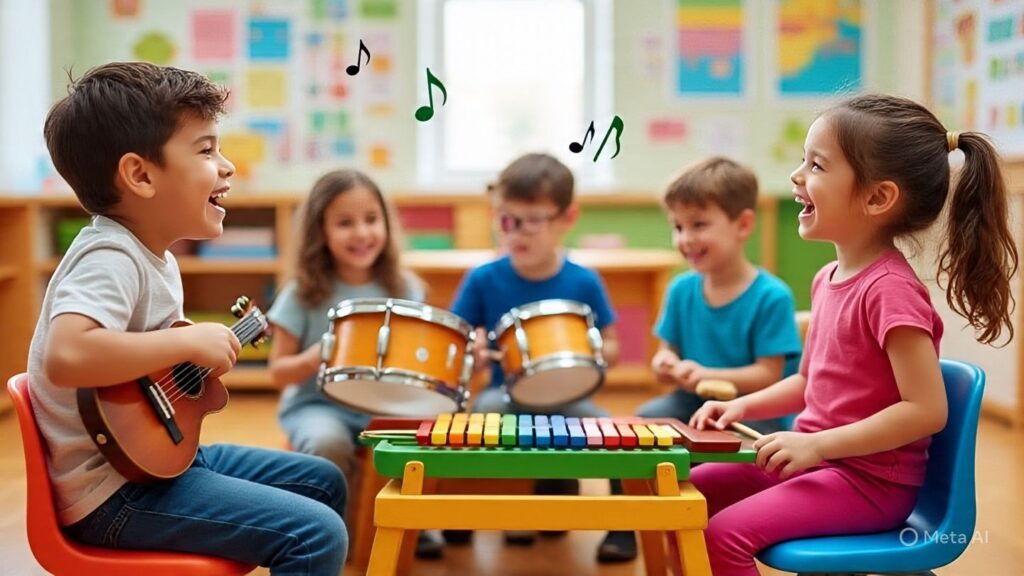Types of Musical Instruments for Kids
Music is a magical part of our lives, and introducing children to musical instruments can open up a world of creativity, fun, and learning. From beating drums to blowing flutes or strumming guitars, instruments help kids develop rhythm, coordination, and even better listening skills. This blog will explore the different types of musical instruments kids can learn about or play, explained in a simple and engaging way.
1. String Instruments
String instruments create sound by vibrating strings. Some are played by plucking, others by using a bow. For kids, string instruments can be exciting and melodic.
- Guitar: One of the most popular instruments. Kids can learn chords and play songs they love. There are smaller versions available for little hands.
- Violin: A bowed instrument that creates beautiful sounds. It helps kids improve posture and concentration.
- Ukulele: A small, four-string instrument. It’s easy for kids to learn and great for singing along.
2. Percussion Instruments
Percussion instruments are perfect for kids who love to move and make noise! These instruments make sound when they are struck, shaken, or scraped.
- Drums: From toy drums to bongos, children can explore beats and rhythms in an energetic way.
- Tambourine: A hand-held instrument that jingles when shaken or tapped. Great for younger kids.
- Maracas: Shakers that are often filled with beads. Kids love shaking them to the beat of music.
3. Wind Instruments
Wind instruments make sound when air is blown into them. These help kids with breath control and lung strength.
- Recorder: A simple flute-like instrument often taught in schools. It’s affordable and easy to learn.
- Harmonica: A small mouth-blown instrument that fits in your pocket. Kids can play melodies and learn about pitch.
- Kazoo: A fun, buzzing instrument that changes the sound of a child’s voice. Very simple to use!
4. Keyboard Instruments
Keyboard instruments let kids explore both melody and harmony. They help children understand musical notes and scales.
- Piano: A classic and powerful instrument. Many kids start learning music with a small keyboard or digital piano.
- Xylophone: A colorful instrument with metal or wooden bars. Kids can hit the bars with mallets to play songs.
5. Electronic Instruments
Technology has introduced kids to a new range of musical instruments that blend sound and play.
- Electric Keyboard: It comes with built-in sounds and rhythms. Perfect for kids interested in different musical styles.
- Drum Pads: Electronic drums that kids can tap to produce sounds. They’re quieter and fun for tech-savvy learners.
Benefits of Learning Musical Instruments
Learning to play an instrument boosts many skills in children:
- Improves memory, focus, and patience.
- Encourages creativity and self-expression.
- Builds confidence and social interaction through group playing or school bands.
- Enhances listening and coordination skills.
How to Choose an Instrument for Your Child
When picking an instrument, consider your child’s age, interest, and physical ability. Let them try different types to see what excites them. Start with simple, easy-to-play instruments and gradually explore more complex ones as they grow.
Fun Ways to Learn About Instruments
There are many ways kids can enjoy learning musical instruments:
- Watch cartoons or videos about instrument families.
- Use musical toys and apps that teach rhythms and sounds.
- Join music classes, online tutorials, or play-along games.
- Visit music stores or concerts to see instruments in action.
Conclusion
Introducing your child to musical instruments is a great way to help them grow emotionally, socially, and intellectually. Whether they love beating drums or playing the piano, music can become a lifelong friend. So hand them an instrument and let the magic begin!
